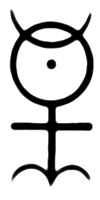Monas Hieroglyphica
This article needs additional citations for verification. (June 2013) |

The Monas Hieroglyphica (or Hieroglyphic Monad) is an esoteric symbol invented and designed by John Dee, the Elizabethan Magus and Court Astrologer of Elizabeth I of England. It is also the title of the 1564 book in which Dee expounds the meaning of his symbol.

The Hieroglyphic embodies Dee's vision of the unity of the Cosmos and is a composite of various esoteric and astrological symbols. Dee wrote a commentary on it which serves as a primer of its mysteries. However, the obscurity of the commentary is such that it is believed that Dee used it as a sort of textbook for a more detailed explanation of the Hieroglyph which he would give in person. In the absence of any remaining detail of this explanation the full significance of the glyph may never be known.
Influence
The existence of the Hieroglyph links Dee to Rosicrucianism, but in what way remains obscure. The Hieroglyph appears on a page of the Rosicrucian Manifesto Chymical Wedding of Christian Rosenkreutz, beside the text of the invitation to the Royal Wedding given to Rosenkreutz who narrates the work. It is indeed at least possible that Dee showed the Glyph to Johannes Valentinus Andreae or even an associate during one of his visits to Central Europe. However, whether Andreae's claims of authoring the treatise hold any weight is still a hotly debated question among scholars.
Frances Yates notes that Dee's influence later "spread to Puritanism in the New World through John Winthrop Jr., an alchemist and a follower of Dee; Winthrop used the 'monas' as his personal mark".[1]
See also
References
- ^ Yates, Frances (1972). The Rosicrucian Enlightenment. London and Boston: Routledge and Kegan Paul Ltd. p. 226.
Bibliography
- The Hieroglyphic Monad by John Dee. Weiser Books 1975. ISBN 1-57863-203-X
- Monas Hieroglyphica Dr Dee. Kessinger Publishing Co 2003. ISBN 0-7661-4744-4
External links
- Text of Monas Hieroglyphica at esotericarchives.com
- Monas hieroglyphica From the Collections of the Library of Congress
- Monas hieroglyphica free from Archive.org
